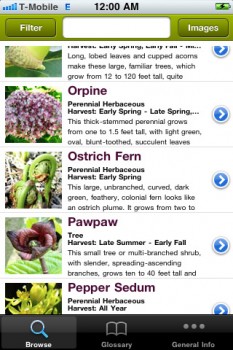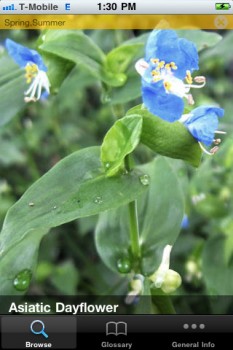
Steve Brill recently released “Wild Edibles,” an iPhone app that helps foragers identify and use edible wild plants. The free version, Wild Edibles Lite, contains 20 common plants, while the full version costs $7.99 and offers “165 edible plants, 52 minor look-alikes, 719 images, and 162 vegan recipes.” The release is compatible with iPhone (iOS 3.0 or later), iPod touch, and iPad, with an Android version currently under development by the software’s creator, WinterRoot LLC.
Considered to be one of the foremost experts in the foraging field, “Wildman” Steve Brill has held wild edible plant tours in and around New York City since 1982 and published several books on foraging and wild food preparation. He is perhaps most well known for his 1986 arrest by undercover NYC park rangers for eating a dandelion in Central Park.
I don’t own an iPhone myself, but I downloaded the free version onto Gregg’s phone the other day to take a look. Even though Wild Edibles Lite only contains 20 plant entries, there are still several plants in there that I don’t yet know, despite the fact that I own Brill’s comprehensive 1994 guide, Identifying and Harvesting Edible and Medicinal Plants in Wild (and Not-So-Wild) Places. (Informative and thorough as that book is, it’s big to be toting into the field and I find the black-and-white botanical illustrations hard to match up definitively to the actual plants—so I often reach for something smaller and in color instead.)

The Wild Edibles (Lite) app fits the bill, however. It is smaller and therefore much more portable, and there are color photos along with the botanical illustrations, making it easier (for me) to make a positive identification. The plants he chose to feature are those found in his own foraging grounds—the eastern United States—although many are widely distributed throughout the country.
In addition to the photos, Brill includes a thorough and easily navigable menu of information about each plant, including general info, habitat, seasons, how to spot, positive identification, confusing factors, similar plants, cautions, harvesting, food uses, nutrition, recipes, and medicinal uses. If a plant has poisonous look-alikes, they are indicated in bold red type. There is also a “filter” option that allows users to search for plants by season, useful parts, habitat, and type (edible, medicinal, or poisonous). Multiple selections are possible, so that if a person want to find all edible plants that grow in spring and summer on the seashore, he or she can make those selections and return a list of edible plants for the given season(s) and locale.
The “Wildman” may have an antiquated (albeit informative) website, but what I’ve seen of his Wild Edibles Lite app is pretty cool. Kudos to Brill (and WinterRoot LLC, which “develops software that bridges ecologically aware practice with information systems”) on reproducing his exhaustive content in such a user-friendly, compact, and modern format. Probably the only feature I don’t see myself making use of are the recipes, on account of the facts that Brill is vegan and I’m not, and that they are a bit complex for a less-than-sophisticated cook like me;) Additional apps available include Foraging Flash Cards if you want to quiz yourself (I passed swimmingly!) and a few other smaller releases such as “Edible Greens” and “Wild Nuts” I have yet to review.
For now, I’m adding the full Wild Edibles app to my wish-list. Perhaps someone will see fit to gift it to me one of these days—though I may kick myself for it later, because it would give Gregg another excuse for having his iPhone out while foraging!

Leave a Reply